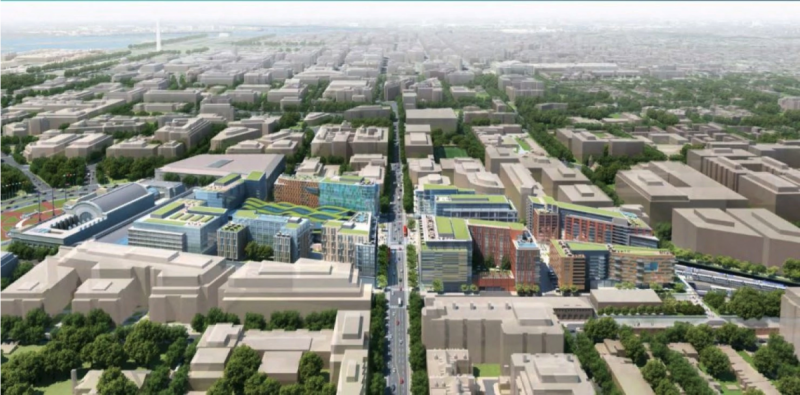Bids, bids, bids: What should we make of the Washington region’s efforts to woo Amazon?

"More boxes, less bids." -this cat, probably. Image by Stephen Woods licensed under Creative Commons.
October 19 marks the deadline for places to submit their bid for Amazon's second headquarters, which has sent cities across the country scrambling to curry favor with the business giant.
Locally, Washington-region jurisdictions are vying (sometimes against each other, to the chagrin of some) to land HQ2, as the second headquarters is dubbed, which the company says could accommodate up to 50,000 workers.
Amazon wants to begin by occupying 500,000 square feet, so the location must have an office building available for use, as well as about 100 acres of space to spread out. You can read their wish list here.
This is a rendering of how Amazon could fit into Northeast DC. Image by DC government.
DC has just released the details of their bid, pitching four different neighborhoods: Capitol Hill East, Shaw-Howard University, NoMa-Union Station, and the Anacostia Riverfront including RFK Stadium and Poplar Point.
On October 9, Fairfax/Loundoun went public with the details of their plan, pitching a 26-acre site near Dulles International Airport that currently includes the Center for Innovative Technology (CIT) campus but is otherwise relatively undeveloped.
Some jurisdictions are potentially offering record incentive packages to sweeten their offers, and our contributors have a lot of mixed feelings about the bids. To begin with the more positive reactions, Dan Reed opined:
Montgomery County won’t share where it’s pitching Amazon, though the rumor is it’s the former White Flint Mall site. I wouldn’t mind Amazon in White Flint, personally, but I actually think Amazon would be a great opportunity for Poplar Point, College Park, or any site on the eastern side of the region, where there aren’t already a lot of jobs and house prices are much lower. 50,000 workers aren’t all going to move to Anacostia (or any neighborhood where Amazon would come), but they’d be more likely to consider homes east of the Anacostia River or in Prince George’s County if HQ2 was nearby, as opposed to if it was in Montgomery or Fairfax counties.
About the Fairfax/Loundoun bid, Canaan Merchant says:
I like the CIT building a lot because from 28 or the toll road it does look like a James Bond Villain's HQ as it pokes above the trees. There's a lot of space there as well and that's one area where sprawl (especially for office space) has really sputtered and not really delivered like how people thought. Metro plus better land use planning could reverse that somewhat, but how much demand is really there? I don't know.
This screenshot shows the Center for Innovative Technology campus in Herndon, Virginia. The area is also Loundon and Fairfax's proposed site for Amazon's HQ2. Image by the author.
Others did not think some of the locations chosen would be good for people already living in those neighborhoods. Discussing DC's bid, David Meni says,
I feel like having an Amazon HQ dropped onto Poplar Point would be a sure-fire way of negating all of the good work in neighborhood sustainability and anti-displacement that's been done with the Community Land Trust that near the 11th Street Bridge Park.
Government officials are putting a lot of time and resources into their Amazon bids. Last week, Bowser's office held a week of efforts called #ObviouslyDC to try to convince Amazon to choose them, while Maryland Governor Larry Hogan has promised deep tax cuts if the company picks Baltimore's Port Covington site.
Some contributors wish these officials would expend their efforts differently. According to Gordon Chaffin:
It's really, really bad public policy to spend your time as a public policy official/elected leader on these ad hoc campaigns for the favored large company of the moment. Do fundamentally sound things–simple things like multi-modal infrastructure and affordable housing–and you're much more likely to attract tomorrow's Amazon.
Nicholas Burger isn't thrilled about Amazon's HQ2 hunt either–and thinks the company itself could do better:
I would love to see a company like Amazon issue a bid that doesn't ask for tax breaks or financial incentives but (1) asks cities to justify that they've got the right fundamentals and (2) commit to investments that would benefit both Amazon and the broader community.
Following up on Chaffin and Burger's points, Travis Maiers added,
In some respects, this reminds me of what happens with sports (both individual teams all the way up to something like the Olympics) and how cities pledge all kinds of incentives and tax breaks and new spending so that they become the chosen spot. But everyone loves a flashy name. And for elected leaders, it can provide a tangible legacy item (“I helped bring X to our city!”) whereas it's much harder to get people to appreciate a new mass-transit corridor or modifications you made to accessory dwelling regulations.
Payton Chung continued:
Of course politicians in a democracy will go after concentrated benefits and diffuse costs, rather than the opposite. Going back to my “instant neighborhoods” post, it's a lot more fun to cut the ribbon at a ceremony with fireworks and marching bands than to dryly report that the same number of units were built in 200 basements over the past year. FWIW, though, incentives *weren't* near the top of Amazon's wish list. In my ranking of RFP evaluation factors, it was a sixth-order consideration, well below many other factors that the media reports all but ignored (e.g., ready in 2019, data connectivity, university access, and ease of travel to other sites).
Finally, Ben Ross ponders,
I wonder how much of this contest is a genuine search for office space, and how much of it is part of Amazon's PR and lobbying offensive to protect its monopoly power. The New York Times has a very good article on the offensive.
What do you think about these bids?
